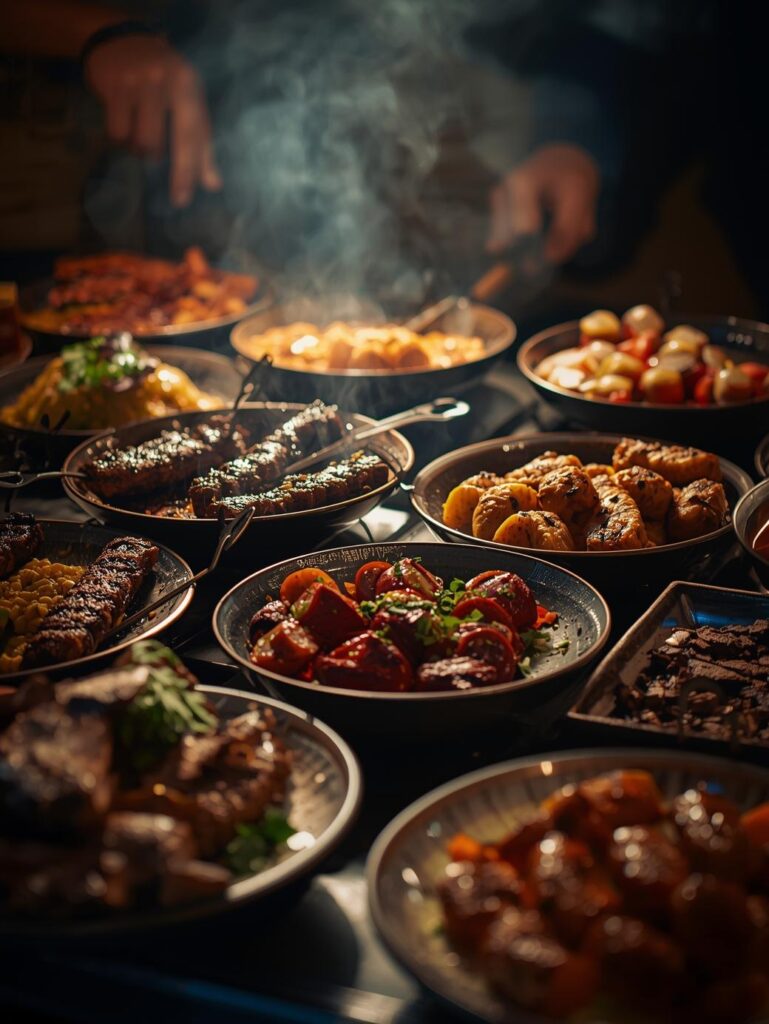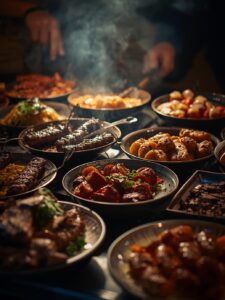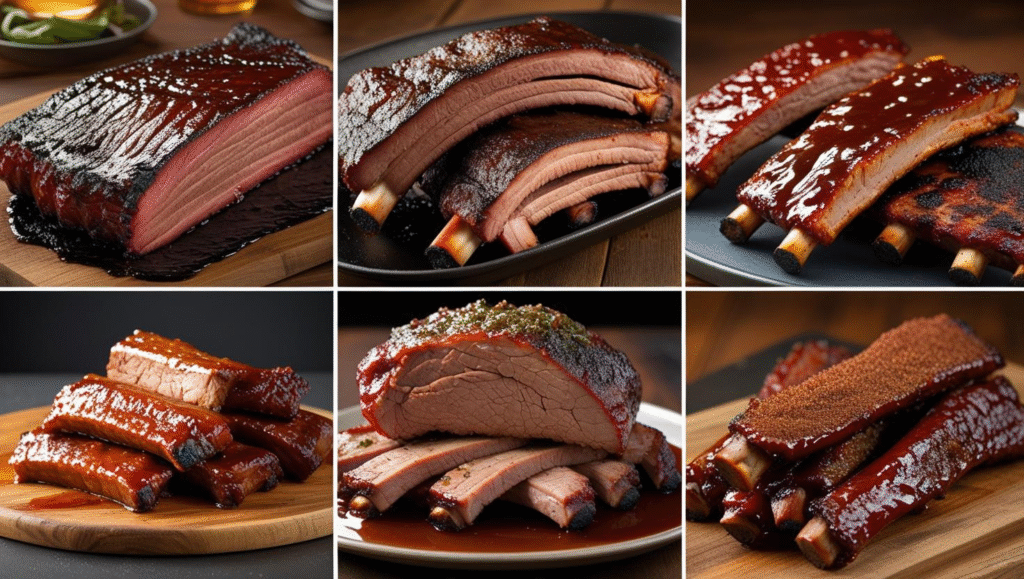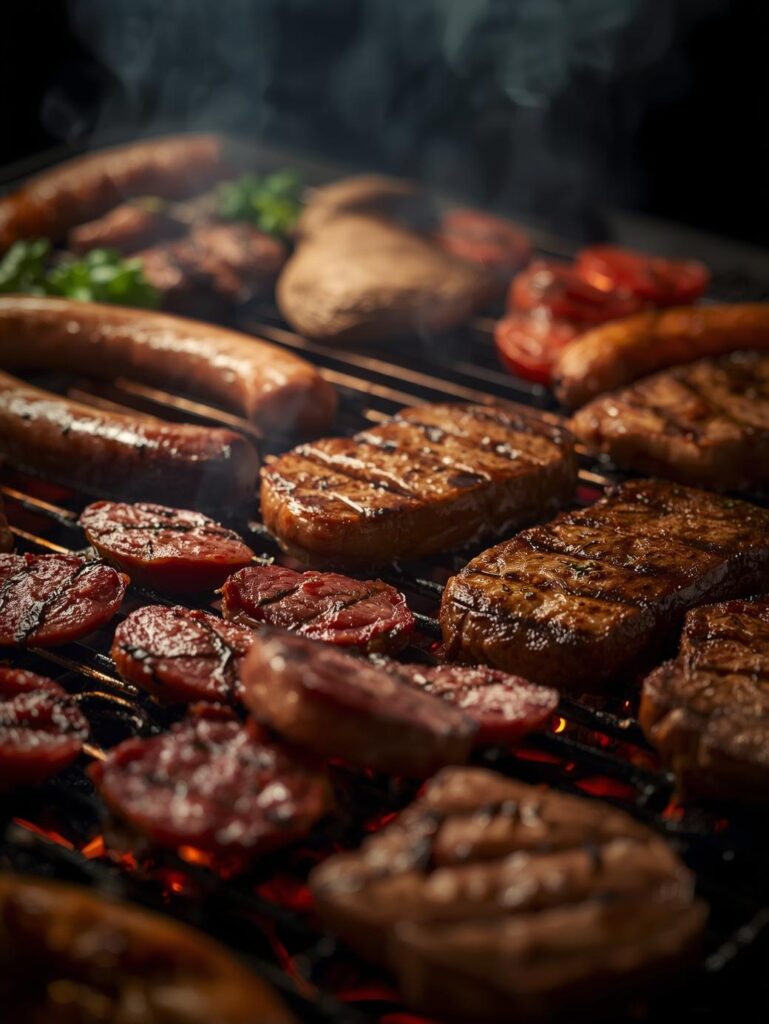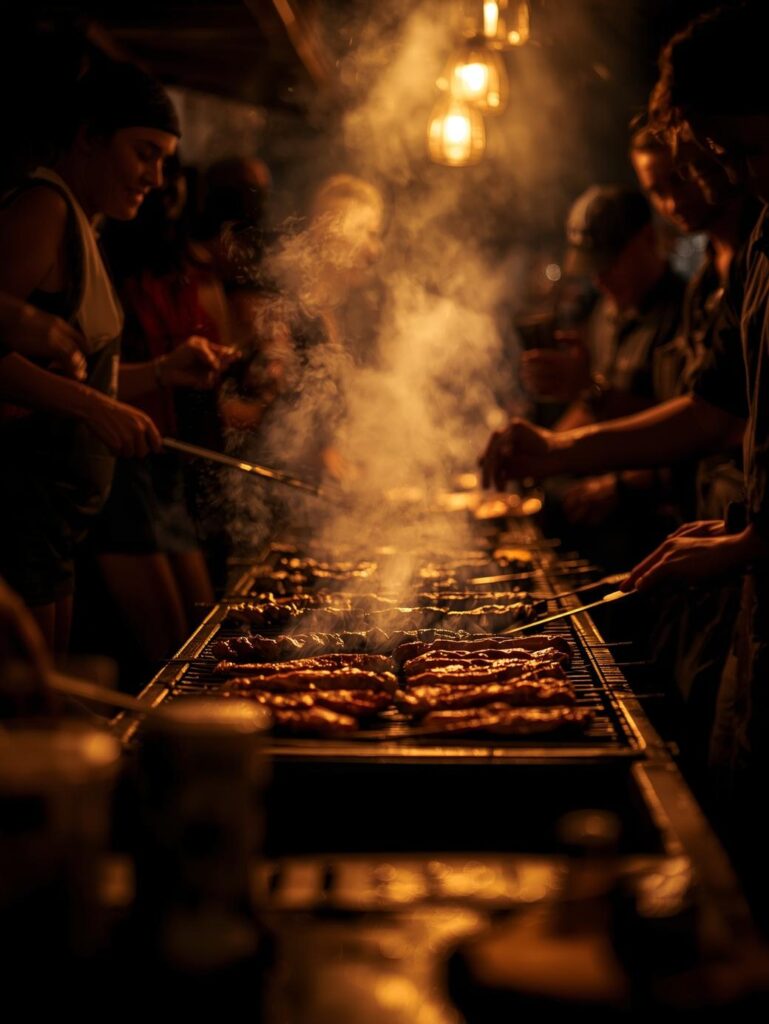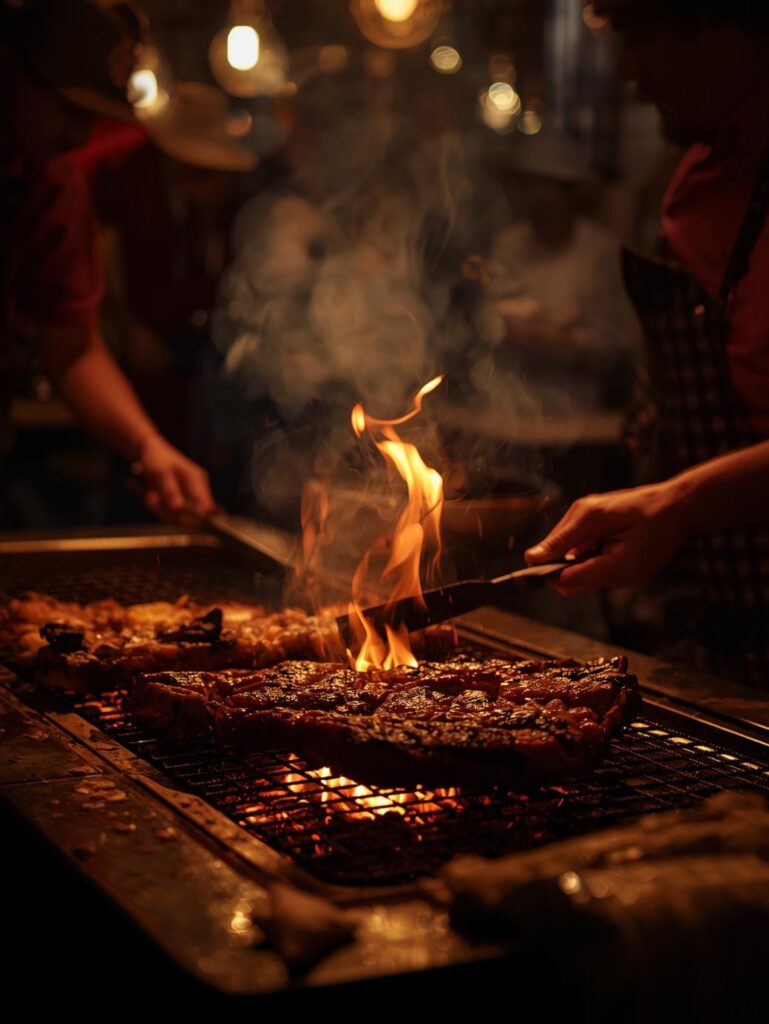Middle Eastern BBQ Expert’s Note: This guide continues our global BBQ series with one of the world’s most aromatic and ancient fire traditions. Middle Eastern grilling isn’t just cooking—it’s a 5,000-year-old conversation between spice routes, trade empires, and Bedouin campfires that created some of the most flavorful and accessible grilled foods on earth. While Americans chase smoke rings and Koreans perfect marinades, the Middle East has been mastering the art of spice blends that transform simple meats into complex culinary poetry.
Middle Eastern Grilling: From Shawarma to Kofta
“In the Middle East, grilling isn’t a method—it’s a language spoken in the dialects of cumin, sumac, and pomegranate. The vertical rotisserie of shawarma whispers stories of Ottoman empires, the pressed kofta kebabs echo Persian poetry, and the simple shish tawook carries the warmth of Mediterranean hospitality. This isn’t just meat on fire; it’s history on a skewer, served with flatbread that’s been baked in clay ovens since the time of the pharaohs.”
Middle Eastern Grilling: From Shawarma to Kofta
Download the Middle Eastern Spice Guide & Grilling Techniques
Ahlan wa sahlan to the world of Middle Eastern grilling—where ancient spice routes meet modern fire mastery. This culinary tradition spans from the Mediterranean coasts of Lebanon to the Persian gardens of Iran, from Turkish bazaars to Egyptian street carts. What unites them all is a profound understanding of how spices, marinades, and fire can elevate simple ingredients into extraordinary meals. This guide will take you through the essential techniques, from the vertical drama of shawarma to the perfect hand-mixed kofta.
🎯 THE MIDDLE EASTERN GRILLING PHILOSOPHY: SPICE AS SOUL
Understanding Middle Eastern grilling means embracing spice blends as the heart of flavor.
⚙️ The Four Pillars of Middle Eastern Fire Culture
Spice, Community, History, and Balance
- The Spice Route Legacy: Middle Eastern cuisine is built on spices that traveled ancient trade routes—cumin from India, sumac from Iran, allspice from the Americas via Turkey. Each blend tells a story of cultural exchange.
- Communal Dining Tradition: Mezze culture means grilling is social—multiple small dishes shared family-style. The grill master feeds everyone continuously throughout the meal.
- Historical Continuity: These techniques haven’t changed much in millennia. The same basic methods—skewers, vertical roasting, ground meat patties—appear in ancient Persian and Arabic texts.
- The Balance Principle: Every rich, spicy grilled meat is balanced by cooling yogurt, sharp pickles, or fresh herbs. It’s a system designed for perfect harmony.
🎯 Middle Eastern vs. Other Grilling Traditions
🇺🇸 American BBQ
- Thick cuts, low & slow
- Smoke flavor dominant
- Dry rubs focus
- Single protein meals
- Sweet & smoky profiles
🇹🇷 Middle Eastern
- Thin cuts, hot & fast
- Spice flavor dominant
- Wet marinades focus
- Multiple small dishes
- Savory & aromatic profiles
🔪 THE MIDDLE EASTERN GRILLING LEXICON: SPEAKING THE LANGUAGE
First rule of Middle Eastern grilling mastery: learn the terms across cultures.
🗣️ Essential Middle Eastern Grilling Terminology
Master the Vocabulary of Eastern Fire
- Shawarma (The Vertical Legend): Stacked, marinated meat cooked on a vertical rotisserie. Lebanese (chicken/beef) vs. Turkish (döner) styles.
- Kofta/Kafta (The Spiced Logs): Ground meat mixed with spices and herbs, pressed onto skewers. Regional variations abound.
- Shish Kebab (The Classic): Cubes of marinated meat on skewers. “Shish” means sword in Turkish.
- Tawook (The Chicken Star): Yogurt-marinated chicken cubes, typically breast meat.
- Mangal (The Grill): The traditional charcoal grill used across the region. Also refers to the grilling event itself.
- Baharat (The Spice Blend): “Spices” in Arabic—the essential seven-spice blend that varies by region.
- Sumac (The Secret Weapon): Tart, crimson spice made from dried berries. The regional “lemon.”
- Mezze (The Spread): Small appetizer dishes served before or with grilled meats.
📊 The Middle Eastern Grilling Matrix: Essential Dishes
🎯 Understanding the Regional Grilling Spectrum
| Dish | Country of Origin | Key Ingredients | Cooking Method | Serving Style |
|---|---|---|---|---|
| Shawarma | Lebanon/Turkey | Lamb, chicken, beef + toum | Vertical rotisserie | Sandwich, plate |
| Kofta/Kafta | Persian/Arab | Ground lamb/beef, parsley, onion | Skewer grilling | With rice, in sandwiches |
| Shish Tawook | Lebanon | Chicken, yogurt, garlic, tomato | Skewer grilling | With garlic sauce, rice |
| Chelow Kabab | Iran | Lamb, saffron, butter | Skewer over rice | With tahdig, sumac |
| Adana Kebab | Turkey | Ground lamb, tail fat, urfa pepper | Flat metal skewer | With flatbread, onions |
| Shish Barak | Syria/Lebanon | Lamb, pine nuts, pomegranate | Skewer grilling | With yogurt sauce |
🌶️ THE SPICE BLEND MASTERY: BUILDING FLAVOR FOUNDATIONS
Middle Eastern grilling begins and ends with spice blends that vary by region and family.
🇱🇧 Lebanese 7-Spice (Baharat)
The All-Purpose Blend
- Black Pepper (2 tbsp): Freshly ground for heat
- Cumin (2 tbsp): Earthy, warm foundation
- Coriander (2 tbsp): Citrusy, floral notes
- Cloves (1 tsp): Intense, sweet warmth
- Nutmeg (1 tsp): Sweet, nutty complexity
- Cinnamon (1 tsp): Sweet woodiness
- Paprika (1 tbsp): Color and mild sweetness
- Cardamom (1 tsp): Floral, eucalyptus notes
🇹🇷 Turkish Kebab Spice
The Robust Blend
- Sumac (3 tbsp): Tart, lemony brightness
- Paprika (2 tbsp): Sweet and smoked varieties
- Thyme (1 tbsp): Earthy, herbal notes
- Maras Pepper (1 tbsp): Turkish chili flakes
- Garlic Powder (1 tbsp): Savory depth
- Mint (2 tsp): Fresh, cooling contrast
- Onion Powder (1 tbsp): Sweet allium base
- Optional: Urfa biber for smoky heat
🔥 MASTERING THE TECHNIQUES: FROM STREET FOOD TO HOME KITCHEN
Each Middle Eastern grilling method has specific techniques for maximum flavor.
🎪 Shawarma: The Vertical Revolution at Home
Recreating Street Magic Without the Spit
- The Stack Method: Layer thin slices of marinated meat, freeze slightly, then slice against the grain to create “fake” shawarma strips.
- Marination Time: 24-48 hours for authentic texture and flavor penetration. The vinegar in the marinade tenderizes while preserving.
- Home Rotisserie Hack: Use a vertical chicken roaster or improvise with a stacked meat cone wrapped around a metal rod.
- Oven Method: Bake marinated strips at 400°F on a rack, then finish under broiler for crispy edges.
- Traditional Spices: Allspice, cardamom, cinnamon, cloves for Lebanese style; cumin, paprika, oregano for Turkish.
- The Garlic Sauce (Toum): Non-negotiable accompaniment. Garlic, oil, lemon emulsion that’s creamy and potent.
🎪 Kofta/Kafta: The Art of Hand-Mixed Meat
Perfecting the Pressed Skewer
- Meat Selection: 80/20 fat ratio minimum. Lamb preferred, but beef/lamb mix common. Fat = flavor and moisture.
- The Hand-Mix Secret: Mix ingredients by hand, not processor. Over-processing makes kofta dense and tough.
- Onion Technique: Grate onion rather than chop. Distributes flavor evenly and adds moisture without chunks.
- Herb Integration: Parsley should be very finely chopped. Some traditions use mint or cilantro variations.
- Skewer Pressing: Use flat metal skewers. Wet hands to prevent sticking, press meat firmly around skewer.
- Cooking Temperature: Medium-high heat (400-450°F). Kofta should sizzle immediately but not burn.
- The Indentation Trick: Press a groove down the center of each kofta log for even cooking.
🍖 THE PERFECT KOFTA FORMULA ACROSS REGIONS
Regional Kofta Variations Compared
| Region | Meat Base | Signature Spices | Herbs | Shape & Cooking |
|---|---|---|---|---|
| Lebanese | Lamb/beef mix | 7-spice, cinnamon | Parsley, mint | Long logs, charcoal |
| Turkish | Lamb only | Cumin, sumac, urfa | Parsley only | Flat pressed, mangal |
| Persian | Lamb, sometimes chicken | Turmeric, advieh | Parsley, tarragon | Small rounds, saffron rice |
| Egyptian | Beef/lamb | Coriander, cumin | Parsley, dill | Football shape, tomato sauce |
| Armenian | Lamb/pork mix | Allspice, paprika | Parsley, basil | Long thin, lavash wrap |
🥙 THE COMPLETE MIDDLE EASTERN GRILLING SPREAD
A proper Middle Eastern grill feast involves multiple components working in harmony.
🧂 The Mezze Starters
- Hummus with olive oil
- Baba ghanoush
- Tabouli salad
- Fattoush bread salad
- Stuffed grape leaves
- Labneh with za’atar
🔥 The Main Grills
- Chicken shawarma
- Lamb kofta kebabs
- Shish tawook
- Lamb chops with sumac
- Ground lamb kebabs
- Grilled halloumi
🍚 The Accompaniments
- Rice with vermicelli
- Fresh pita or lavash
- Garlic sauce (toum)
- Tahini sauce
- Pickled turnips
- Grilled vegetables
🌿 The Fresh Elements
- Mint, parsley, cilantro
- Sliced radishes
- Green onions
- Tomato & cucumber
- Lemon wedges
- Olives & pickles
🚨 MIDDLE EASTERN GRILLING TROUBLESHOOTING: COMMON MISTAKES
🎯 Fixing Common Middle Eastern Grilling Problems
| Problem | Arabic/Turkish Term | Cause | Solution |
|---|---|---|---|
| Dry Kofta | “Kafta nayif” | Lean meat, overmixing, high heat | More fat, hand mix, medium heat |
| Bland Marinade | “Marinate tasteless” | Insufficient time, weak spices | 24+ hours, toast spices, enough salt |
| Falling Off Skewer | “Sisden düşüyor” | Poor adhesion, wrong meat texture | Press firmly, chill before grilling |
| Burnt Spices | “Baharat mahruka” | High heat, sugar in marinade | Medium heat, wipe excess marinade |
| Tough Shawarma | “Shawarma qasī” | Wrong cut, insufficient marination | Use shoulder/thigh, marinate 48h |
🏁 MASTERING THE ANCIENT ART OF EASTERN FIRE
Mastering Middle Eastern grilling means connecting with culinary traditions that span millennia and continents. This isn’t just about replicating restaurant dishes—it’s about understanding the spice balances, textural contrasts, and communal spirit that make this cuisine so vibrant and enduring. From the vertical theater of shawarma to the humble perfection of well-spiced kofta, each dish tells a story of trade routes, migrations, and shared meals.
Your Middle Eastern grilling journey starts with the spices—toasting, grinding, and blending until you find your perfect balance. Then comes mastering the techniques specific to each dish, from the pressed skewer of kofta to the thin slicing of shawarma. Finally, you’ll discover the joy of building complete meals where every component—from the sharpness of pickles to the creaminess of garlic sauce—plays its part in creating perfect harmony.
So gather your spices, fire up the mangal, and remember the three rules of Middle Eastern grilling mastery: spice with abandon, balance your flavors, and always eat with community. Your journey to becoming a master of Eastern fire starts now.
🌍 START WITH BAHARAT SPICE BLEND →
Master the essential seven-spice blend that forms the foundation of Middle Eastern grilling
No posts found.
Explore More Mediterranean & Middle Eastern Traditions: Continue your journey through the cradle of civilization’s fire cuisine.

